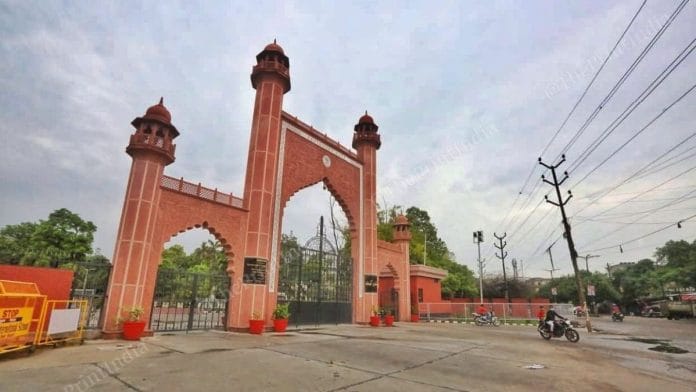On his last working day as Chief Justice of India, DY Chandrachud delivered, or rather under-delivered, a much-awaited verdict on the minority status of Aligarh Muslim University. Instead of giving a conclusive answer after years of legal back and forth, the court just laid out the framework for assessing minority status, passing the actual decision on AMU to a future three-judge bench.
AMU’s minority character is no ordinary matter—it has drawn the attention of the Supreme Court for 18 years and, arguably, has as many socio-political and historical dimensions as legal ones. For instance, the Bharatiya Janata Party (BJP) has consistently opposed AMU’s ‘minority’ status, pushing instead for reservations for Scheduled Castes, Scheduled Tribes, and Other Backward Classes. This even though Article 15(5) of the Constitution exempts minority educational institutions—as defined under Article 30(1)—from reserving seats for SCs, STs, and OBCs.
The fractious 4:3 ratio of the AMU judgment mirrors the public divide on the issue. The ruling has drawn much attention, with commentators rushing to either celebrate or decry it. Hence, it is important to decode the judgment and its wider implications on law, society, and polity.
The crux of the judgment
The 500-page AMU judgment is split into two parts. The majority opinion, spanning 118 pages, was penned by Chief Justice DY Chandrachud, also representing the views of Justices Sanjiv Khanna, JB Pardiwala, and Manoj Misra. The minority opinion comprises three separate writings by Justices Surya Kant, Dipankar Datta, and SC Sharma, running into 102, 88, and 193 pages, respectively.
The most important aspects of the binding majority ruling can be broken down into four points.
First, it overturns the 1967 Supreme Court judgment in S Azeez Basha, which held that since AMU was a Central university, it could not be considered a minority institution under Article 30.
Second, it laid down the parameters required for an institution to be established by a minority to meet the constitutional test under Article 30—including factors such as how the institution was founded, its history, the community involved, and other aspects.
Third, the incorporation of an institution through a statute is not tantamount to its establishment but is simply a procedural requirement that does not dilute its minority character.
Fourth, the main issue—whether AMU qualifies as a minority institution—will be determined by a separate bench of three judges based on the parameters laid down by the court.
It seems odd that the judgment does not go further to apply its neatly devised principles to the facts of AMU. Instead, it directs that a fresh, regular (not constitutional) bench be constituted to apply these criteria to determine whether AMU has minority status.
Typically, when a Constitution bench adjudicates a constitutional issue, it also resolves the specific dispute that brought that issue before the court. Here, however, the court seems to have segregated questions of ‘law’ from questions of ‘fact’—with the Constitution bench addressing the former and leaving the latter to be decided later by the three-judge bench. Given that the court had concluded the hearings in February, with the judgment reserved for nine months, one could argue that it might have conducted additional hearings to examine the facts and clarify whether AMU qualifies to be covered under the parameters evolved.
Minority does what majority didn’t
The minority opinion questions this deferral. Justice Dipankar Datta, for instance, wrote in his dissenting opinion that it bothered his “conscience”.
“After almost 9 (nine) months the judgment came to be reserved, it pricks my conscience to send the matter back once again to an appropriate bench; more so, after both sides have exhaustively addressed us on the very issue as to whether AMU answers the characteristics of a minority institution,” he wrote.
Justice Datta also questioned the time and resources this would take.
“In present times, when there is a lot of emphasis on pendency of cases and expeditious disposal thereof, precious judicial time would be wasted if the same issue has to be agitated yet again when such time could be well utilised in answering other pressing questions of law,” his opinion read.
Interestingly, after making this critique, Justice Datta’s dissenting opinion proceeded to do what the majority refrained from doing—applying the principles directly to the facts of AMU’s case. It notes that the arguments in the “specific factual context of AMU” were extensive and provided enough substance for the court to make a determination on the university’s case. He then interprets these submissions, ultimately concluding that AMU does not, in fact, have minority status.
This instance alone illustrates the stark disparities between the majority and minority opinions in their approach to evaluating the submissions made before the bench by both parties.
It also raises another important question—to what extent might the minority opinion, which delves more deeply into the “specific factual context of AMU”, become relevant for the appropriate bench? While the majority ruling implicitly suggests that it is very likely that AMU, as it currently exists, will meet all the requirements set out by the court for minority institutions, there remains space for the future bench to draw from both the majority and dissenting opinions. This is especially so because the minority opinions appear to be more explicit in answering—in the negative—whether AMU satisfies the parameters devised by the majority, such as on the university’s establishment.
The judgment has kept the curtains drawn. The court has essentially sent the question back to itself to decide the future.
Mohammad Nasir is Assistant Professor of Law at Aligarh Muslim University and author of Syed Mahmood: Colonial India’s Dissenting Judge (Bloomsbury 2022); he posts on X @Mohamma55165777. Taha Bin Tasneem is Lead, Grievance Redressal and Strategic Intervention at Mission Accessibility, New Delhi. Aleema Nishat reads law at Aligarh Muslim University. Views are personal.
(Edited by Asavari Singh)






